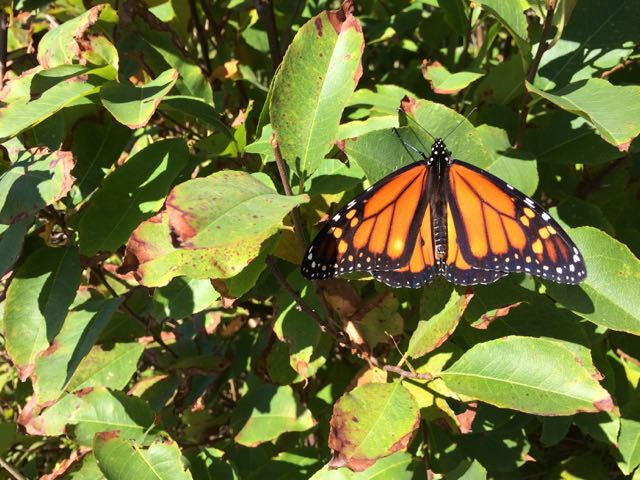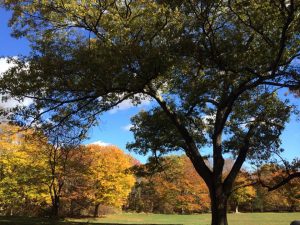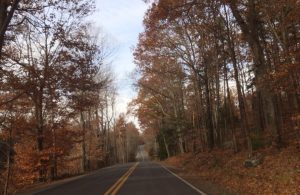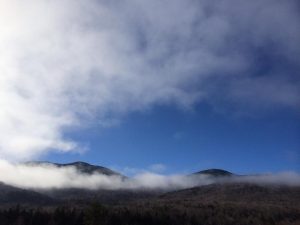
New England’s Seasonal Changes are Changing

This year’s foliage was the most stunning and prolonged display of color in recent memory, a vibrant progression of crimson, orange, gold, and russet that went on for weeks and weeks. While the drought certainly had something to do with it, warming temperatures are also responsible for later peaks in fall foliage.
In mid-November, against this backdrop of recently fallen leaves and snowless mountains, researchers with the Northeast Phenology Network gathered with graduate students, volunteers, and representatives of the National Park Service, land trusts, conservation organizations, and the Appalachian Mountain Club to discuss how the natural environment is changing.
Their focus was phenology, the science of seasonal life cycle changes in plants and animals and the subject of Maine Sea Grant and University of Maine Cooperative Extension’s Signs of the Seasons program. The practice of phenology dates back thousands of years and is now gaining new popularity as a simple way to monitor the local effects of global climate change.
“Both citizen scientists and researchers are observing the changes in the timing of plant and animal life stages throughout the Northeast, looking at different research questions including the timing of leaf out, bird migration, and rockweed reproduction in the intertidal zone,” said Esperanza Stancioff, co-coordinator of Signs of the Seasons with UMaine Extension and Maine Sea Grant. This meeting offered an opportunity to learn from each other, incorporating the collective knowledge into our research and citizen science programs, as well as to continue our connections with each other into the future.”
Using direct observation, remote sensing, historical data, and nineteenth-century botanical collections, scientists and citizens working together have built a catalog of New England’s changing seasons.
Here is what they reported.

Changes are not consistent, but overall there has been a four-day per decade shift in plant and animal response to warming temperatures, according to a meta-analysis presented by Heather Kharouba of University of Ottawa.
Non-native, invasive species are more flexible. New England trees like oak, elm, and ash need the winter “chilling period” in order to prepare their flowers and leaves. Native shrubs have a fear of frost not shared by invasives, which leaf out readily and early given enough warmth, said Richard Primack of Boston University, a leading phenology researcher best known for revisiting plants observed by Henry David Thoreau. The leaves come out in spring one to two weeks earlier than during Thoreau’s time.
A graduate student working with Primack, Caitlin McDonough McKenzie, has studied plants along the Appalachian Trail and in Acadia National Park. She documented a relationship between average March-April temperatures and plant responses: a one-degree increase in temperature correlates with a nearly two-day earlier shift in leaf out and flowering along Sargent, Pemetic, and Cadillac mountains in Acadia, which is among the seventy-five percent of national parks experiencing an earlier spring.
It’s not just spring that’s changing. Amanda Gallinat, another student in Primack’s lab, studies autumn, which she calls the neglected season. Fall changes are a bit messier to study. Birds departing, fruit ripening, and leaves falling are “really complicated,” said Gallinat. Birds are delaying their southward migrations, passing through New England later in the season when the available berries and seeds are mostly invasive shrubs and vines, as native shrubs are fruiting about a month earlier. But diet analysis suggests the birds still prefer to eat the fruit of native shrubs. Are the birds just eating all the native berries before the researchers can count them? Does their preference for native fruit mean the birds aren’t getting enough energy to continue their migration?

All of these studies only lead to more questions. Never before have so many people been paying so much attention to natural details. What in the past was the reliable calendar of the New England year is now the subject of research and a major indicator of a changing climate.
To Seth Benz of Schoodic Institute, observing the natural world is our responsibility as “ecological citizens.” For most people, contact with the outside is minimal and superficial. When we only access nature from our couches and keyboards, we become disconnected, unaware, apathetic to the degradation and extinction that surrounds us. “We can no longer put our human relationship with nature into an intellectual box,” said Benz. We have to pay attention. We have to notice.
This Friday, #OptOutside. And collect a few data points while you’re out there. Scientists studying our changing seasons need all the help they can get.
Ways to participate in phenology science:
Signs of the Seasons – participants observe common plants or animals in a backyard, local park, or favorite trail.
iNaturalist.org – an online social network for anyone to share observations and learn about the natural world.
eBird – a way for bird watchers to help conservationists learn more about birds and their habitats.
